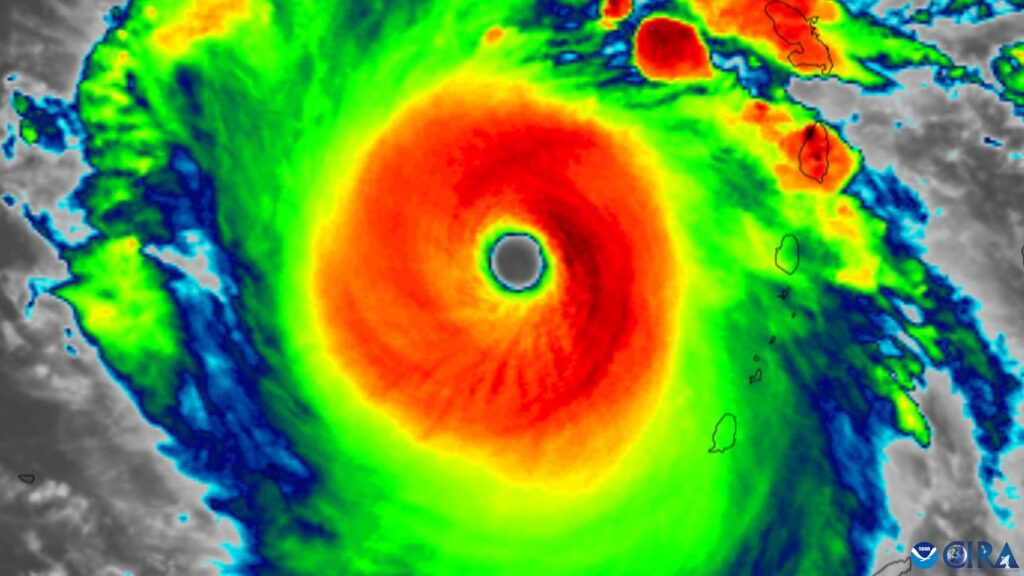Hurricane Beryl was named on June 28, and meteorologists have tracked its progress for more than two weeks. The exceptionally long-lived system has traveled over 6,000 miles, passing through the Atlantic, the Caribbean, the Bay of Campeche and the Gulf of Mexico, making three landfalls as a destructive hurricane while setting records.
At long last, though, Beryl is about to fade away. The storm has devolved into a “post-tropical cyclone,” or a leftover mid-latitude low-pressure swirl, and is trekking through Canada. In its wake, more than 1 million Houston-area customers are still without power, and people across the Mississippi and Ohio valleys and the Northeast are cleaning up from tornadoes and flooding spurred by Beryl’s remnants.
The storm caused the most severe damage in Grenada, where Beryl hit at Category 4 strength on July 1. It became a Category 5 shortly after.
Here we look back on Beryl’s journey and highlight key moments in its historic march across the Atlantic, Caribbean and United States.
16 days ago: The first National Hurricane Center outlook identified an area of disturbed weather over the eastern tropical Atlantic. It had emerged from the coast of Africa a day earlier on June 24. That was the tropical wave that would eventually become Beryl.
13 days ago: On June 28, the tropical wave became a tropical depression — the precursor to a named storm. The initial advisory noted that the storm could eventually become a hurricane as it hit the Lesser Antilles. The system was named Beryl at 11 p.m. Atlantic time.
12 days ago: Just 24 hours after being declared a tropical depression, Beryl became a 75 mph Category 1 hurricane 720 miles east-southeast of Barbados. A hurricane warning was hoisted for Barbados, with hurricane watches issued for St Lucia, St. Vincent and the Grenadine Islands and Grenada. (Grenada is where Beryl would eventually strike first.)
11 days ago: At 5 p.m. Atlantic time on June 30, Beryl was declared an “extremely dangerous Category 4 hurricane.” Maximum sustained winds were listed at 130 mph. This made Beryl the farthest-south Category 4 on record in the Atlantic, the earliest-forming Category 4 on record and the fastest-intensifying storm on record anytime before September.
10 days ago: On the morning of July 1, Beryl hit Carriacou, Grenada, swallowing the island in its 140 mph eyewall, or ring of destructive winds surrounding its center. Severe damage was reported. By 11 p.m. Atlantic time, Beryl became a Category 5 hurricane — the earliest on record. It would intensify overnight with winds of 160 mph.
9 days ago: On July 2, estimated maximum sustained winds in the core of Beryl reached 165 mph — 8 mph over the threshold for Category 5 status. That made it the strongest July storm on record in the Atlantic.
8 days ago: On July 3, Beryl scraped southern Jamaica as a Category 4 storm, with the eyewall shaving the southern edge of the island.
7 days ago: On July 4, Beryl’s northern side clipped the Cayman Islands as a Category 3 storm. Its violent eyewall winds stayed south of the island, meaning the Caymans mainly suffered tropical storm impacts.
6 days ago: On July 5, Beryl hit Mexico’s Yucatán Peninsula. It made landfall as a high-end Category 2 with 110 mph winds, though it weakened quickly after landfall near Tulum.
5 days ago: On July 6, Beryl emerged in the southwest Gulf of Mexico as a tropical storm, having weakened and lost much of its inner core. It spent much of the next day trying to reorganize.
4 days ago: By 11 p.m. Central time on July 7, Beryl regained its status as a hurricane.
3 days ago: At 4 a.m. Central on Monday, Beryl made landfall in Matagorda, Tex., as a Category 1 hurricane. A last-minute jog to the east put Houston in the eastern eyewall — the most ferocious part of the storm. That blasted the metro area with 80 mph winds and dumped up to a foot of rain. Roughly 2.5 million customers lost power. Then an afternoon tornado outbreak swirled up across northeast Texas, southern Arkansas and western Louisiana. The National Weather Service issued 115 tornado warnings, a July record.
2 days ago: On June 9, Beryl was downgraded to a tropical depression as it slid along the Indiana-Ohio border. Its leftover swirl helped spawn several tornadoes, including a destructive twister in Mount Vernon, Ind., that demolished a warehouse.
One day ago: As Beryl’s remnant low pressure skirted along the border of eastern Canada and the northeastern United States, leftover spin helped generate rotating thunderstorms and several tornadoes in New York and neighboring states. In New York, the National Weather Service issued a state record 42 tornado warnings in a single day, leading to a grand total of more than 200 during Beryl’s three-day trek across the Lower 48 states. Significant flooding, with rainfall totals of 4 to 6 inches, meanwhile, plagued northern Vermont.
Thursday: Beryl has dissipated into a post-tropical low-pressure system northeast of Lake Ontario in southern Canada.
Source link : https://www.washingtonpost.com/weather/2024/07/11/hurricane-beryl-journey-caribbean-jamaica-texas-newyork/
Author :
Publish date : 2024-07-11 19:31:11
Copyright for syndicated content belongs to the linked Source.
